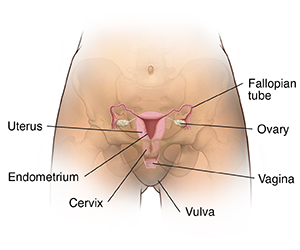-
Endometrium. The lining of the uterus.
-
Uterus. Also called the womb, the uterus is a hollow, pear-shaped organ located in a person's lower abdomen, between the bladder and the rectum.
-
Ovaries. Two female reproductive organs located in the pelvis.
-
Fallopian tubes. Carry eggs from the ovaries to the uterus.
-
Cervix. The lower, narrow part of the uterus (womb) located between the bladder and the rectum. It forms a canal that opens into the vagina, which leads to the outside of the body.
-
Vagina. The passageway through which fluid passes out of the body during menstrual periods. It's also called the "birth canal." The vagina connects the cervix (the opening of the womb, or uterus) and the vulva (the external genitalia).
-
Vulva. The external portion of the female genital organs.
Featured in


